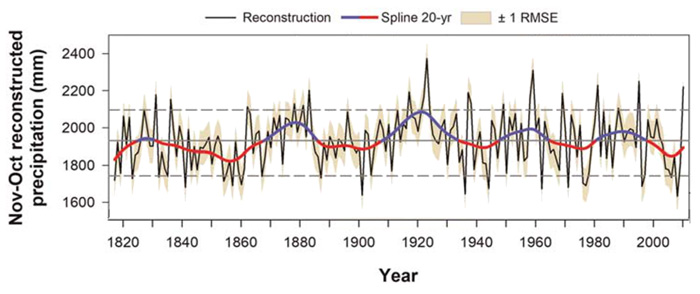| Tweet | Follow @co2science |
Paper Reviewed
Humanes-Fuente, V., Ferrero, M.E., Muñoz, A.A., González-Reyes, A., Requena-Rojas, E.J., Barichivich, J., Inga, J.G. and Layme-Huaman, E.T. 2020. Two centuries of hydroclimatic variability reconstructed from tree-ring records over the Amazonian Andes of Peru. Journal of Geophysical Research: Atmospheres 125, e2020JD032565.
According to Humanes-Fuente et al. (2020), "longer records are needed to improve our understanding of rainfall variability and summer monsoon behavior at various scales." One region of the globe for which this statement is particularly pertinent is the eastern slopes of the Peruvian Andes, which includes the upper watersheds of the Peruvian Amazon River. Given its complex topography and a lack of instrumental data, little is known about historic trends in rainfall for this area -- until now!
Using a set of 120-tree-ring width series from tree species Cedrela odorata, Cedrela nebulosi and Juglans neotropica, which were well-correlated with short-term instrumental precipitation data (1979-2010), Humanes-Fuente et al. were able to create "the first annually resolved precipitation reconstruction for the tropical Andes of Peru" covering the period 1817-2010. The resultant proxy is displayed in Figure 1 below.
As noted in the figure, and in the words of the authors, the precipitation reconstruction "shows decadal to multidecadal variations with several below- and above-the-mean precipitation intervals." The top five wettest ten-year periods included (1) 1915-1924, (2) 1875-1884, (3) 1951-1960, (4) 1980-1989 and (5) 1924-1933, whereas the top five driest ten-year periods occurred during the intervals of (1) 1852-1861, (2) 2000-2009, (3) 1841-1850, (4) 1970-1979 and (5) 1832-1841. Nevertheless, despite the interannual and decadal periodicities in the record, there appears to be nothing unusual, unnatural or unprecedented in the Peruvian tropical Andes precipitation record in recent years that might indicate a CO2 influence. Spectral and wavelet statistical analyses of the record, however, did indicate significant oscillatory modes associated with ENSO (2-7 years) and the Atlantic Multidecadal Oscillation (~40 years; AMO), of which the authors say they are "the main large-scale climate forcings that have influenced precipitation at interannual-to-multidecadal scales over the Andes-Amazon Region during the past two centuries." And given their influence in the past, it is likely they will continue to exert an influence in the future, independent of rising CO2.

Figure 1. Proxy record of annual (Nov-Oct) precipitation in the eastern slopes of the Peruvian Andes over the period 1817-2010, derived from tree-ring data. Source: Humanes-Fuente et al. (2020).




